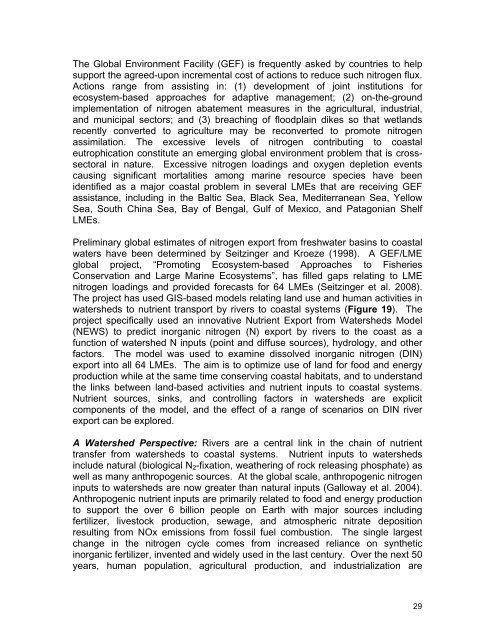Sustaining the World's Large Marine Ecosystems
Sustaining the World's Large Marine Ecosystems
Sustaining the World's Large Marine Ecosystems
You also want an ePaper? Increase the reach of your titles
YUMPU automatically turns print PDFs into web optimized ePapers that Google loves.
The Global Environment Facility (GEF) is frequently asked by countries to help<br />
support <strong>the</strong> agreed-upon incremental cost of actions to reduce such nitrogen flux.<br />
Actions range from assisting in: (1) development of joint institutions for<br />
ecosystem-based approaches for adaptive management; (2) on-<strong>the</strong>-ground<br />
implementation of nitrogen abatement measures in <strong>the</strong> agricultural, industrial,<br />
and municipal sectors; and (3) breaching of floodplain dikes so that wetlands<br />
recently converted to agriculture may be reconverted to promote nitrogen<br />
assimilation. The excessive levels of nitrogen contributing to coastal<br />
eutrophication constitute an emerging global environment problem that is crosssectoral<br />
in nature. Excessive nitrogen loadings and oxygen depletion events<br />
causing significant mortalities among marine resource species have been<br />
identified as a major coastal problem in several LMEs that are receiving GEF<br />
assistance, including in <strong>the</strong> Baltic Sea, Black Sea, Mediterranean Sea, Yellow<br />
Sea, South China Sea, Bay of Bengal, Gulf of Mexico, and Patagonian Shelf<br />
LMEs.<br />
Preliminary global estimates of nitrogen export from freshwater basins to coastal<br />
waters have been determined by Seitzinger and Kroeze (1998). A GEF/LME<br />
global project, “Promoting Ecosystem-based Approaches to Fisheries<br />
Conservation and <strong>Large</strong> <strong>Marine</strong> <strong>Ecosystems</strong>”, has filled gaps relating to LME<br />
nitrogen loadings and provided forecasts for 64 LMEs (Seitzinger et al. 2008).<br />
The project has used GIS-based models relating land use and human activities in<br />
watersheds to nutrient transport by rivers to coastal systems (Figure 19). The<br />
project specifically used an innovative Nutrient Export from Watersheds Model<br />
(NEWS) to predict inorganic nitrogen (N) export by rivers to <strong>the</strong> coast as a<br />
function of watershed N inputs (point and diffuse sources), hydrology, and o<strong>the</strong>r<br />
factors. The model was used to examine dissolved inorganic nitrogen (DIN)<br />
export into all 64 LMEs. The aim is to optimize use of land for food and energy<br />
production while at <strong>the</strong> same time conserving coastal habitats, and to understand<br />
<strong>the</strong> links between land-based activities and nutrient inputs to coastal systems.<br />
Nutrient sources, sinks, and controlling factors in watersheds are explicit<br />
components of <strong>the</strong> model, and <strong>the</strong> effect of a range of scenarios on DIN river<br />
export can be explored.<br />
A Watershed Perspective: Rivers are a central link in <strong>the</strong> chain of nutrient<br />
transfer from watersheds to coastal systems. Nutrient inputs to watersheds<br />
include natural (biological N2-fixation, wea<strong>the</strong>ring of rock releasing phosphate) as<br />
well as many anthropogenic sources. At <strong>the</strong> global scale, anthropogenic nitrogen<br />
inputs to watersheds are now greater than natural inputs (Galloway et al. 2004).<br />
Anthropogenic nutrient inputs are primarily related to food and energy production<br />
to support <strong>the</strong> over 6 billion people on Earth with major sources including<br />
fertilizer, livestock production, sewage, and atmospheric nitrate deposition<br />
resulting from NOx emissions from fossil fuel combustion. The single largest<br />
change in <strong>the</strong> nitrogen cycle comes from increased reliance on syn<strong>the</strong>tic<br />
inorganic fertilizer, invented and widely used in <strong>the</strong> last century. Over <strong>the</strong> next 50<br />
years, human population, agricultural production, and industrialization are<br />
29









